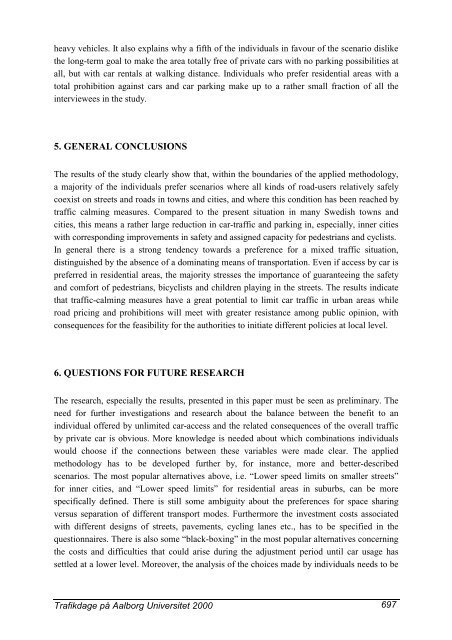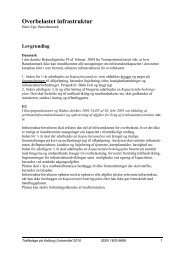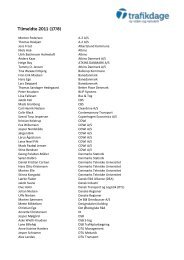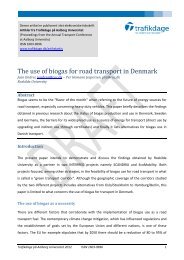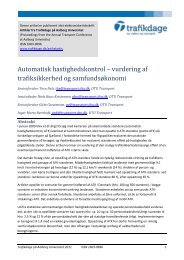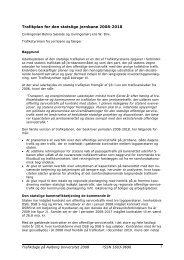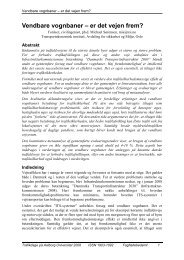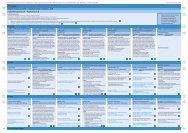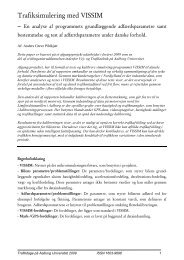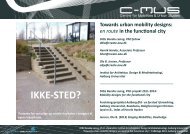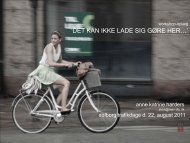Hent paperet som PDF-fil - Trafikdage.dk
Hent paperet som PDF-fil - Trafikdage.dk
Hent paperet som PDF-fil - Trafikdage.dk
Create successful ePaper yourself
Turn your PDF publications into a flip-book with our unique Google optimized e-Paper software.
heavy vehicles. It also explains why a fifth of the individuals in favour of the scenario dislike<br />
the long-term goal to make the area totally free of private cars with no parking possibilities at<br />
all, but with car rentals at walking distance. Individuals who prefer residential areas with a<br />
total prohibition against cars and car parking make up to a rather small fraction of all the<br />
interviewees in the study.<br />
5. GENERAL CONCLUSIONS<br />
The results of the study clearly show that, within the boundaries of the applied methodology,<br />
a majority of the individuals prefer scenarios where all kinds of road-users relatively safely<br />
coexist on streets and roads in towns and cities, and where this condition has been reached by<br />
traffic calming measures. Compared to the present situation in many Swedish towns and<br />
cities, this means a rather large reduction in car-traffic and parking in, especially, inner cities<br />
with corresponding improvements in safety and assigned capacity for pedestrians and cyclists.<br />
In general there is a strong tendency towards a preference for a mixed traffic situation,<br />
distinguished by the absence of a dominating means of transportation. Even if access by car is<br />
preferred in residential areas, the majority stresses the importance of guaranteeing the safety<br />
and comfort of pedestrians, bicyclists and children playing in the streets. The results indicate<br />
that traffic-calming measures have a great potential to limit car traffic in urban areas while<br />
road pricing and prohibitions will meet with greater resistance among public opinion, with<br />
consequences for the feasibility for the authorities to initiate different policies at local level.<br />
6. QUESTIONS FOR FUTURE RESEARCH<br />
The research, especially the results, presented in this paper must be seen as preliminary. The<br />
need for further investigations and research about the balance between the benefit to an<br />
individual offered by unlimited car-access and the related consequences of the overall traffic<br />
by private car is obvious. More knowledge is needed about which combinations individuals<br />
would choose if the connections between these variables were made clear. The applied<br />
methodology has to be developed further by, for instance, more and better-described<br />
scenarios. The most popular alternatives above, i.e. “Lower speed limits on smaller streets”<br />
for inner cities, and “Lower speed limits” for residential areas in suburbs, can be more<br />
specifically defined. There is still <strong>som</strong>e ambiguity about the preferences for space sharing<br />
versus separation of different transport modes. Furthermore the investment costs associated<br />
with different designs of streets, pavements, cycling lanes etc., has to be specified in the<br />
questionnaires. There is also <strong>som</strong>e “black-boxing” in the most popular alternatives concerning<br />
the costs and difficulties that could arise during the adjustment period until car usage has<br />
settled at a lower level. Moreover, the analysis of the choices made by individuals needs to be<br />
<strong>Trafikdage</strong> på Aalborg Universitet 2000 697


